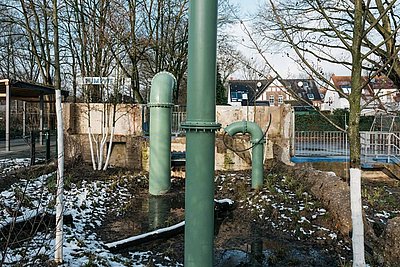Welcome at the Interface Culture program website.
Acting as creative artists and researchers, students learn how to advance the state of the art of current interface technologies and applications. Through interdisciplinary research and team work, they also develop new aspects of interface design including its cultural and social applications. The themes elaborated under the Master's programme in relation to interactive technologies include Interactive Environments, Interactive Art, Ubiquitous Computing, game design, VR and MR environments, Sound Art, Media Art, Web-Art, Software Art, HCI research and interaction design.

The Interface Culture program at the Linz University of Arts Department of Media was founded in 2004 by Christa Sommerer and Laurent Mignonneau. The program teaches students of human-machine interaction to develop innovative interfaces that harness new interface technologies at the confluence of art, research, application and design, and to investigate the cultural and social possibilities of implementing them.
The term "interface" is omnipresent nowadays. Basically, it describes an intersection or linkage between different computer systems that makes use of hardware components and software programs to enable the exchange and transmission of digital information via communications protocols.
However, an interface also describes the hook-up between human and machine, whereby the human qua user undertakes interaction as a means of operating and influencing the software and hardware components of a digital system. An interface thus enables human beings to communicate with digital technologies as well as to generate, receive and exchange data. Examples of interfaces in very widespread use are the mouse-keyboard interface and graphical user interfaces (i.e. desktop metaphors). In recent years, though, we have witnessed rapid developments in the direction of more intuitive and more seamless interface designs; the fields of research that have emerged include ubiquitous computing, intelligent environments, tangible user interfaces, auditory interfaces, VR-based and MR-based interaction, multi-modal interaction (camera-based interaction, voice-driven interaction, gesture-based interaction), robotic interfaces, natural interfaces and artistic and metaphoric interfaces.
Artists in the field of interactive art have been conducting research on human-machine interaction for a number of years now. By means of artistic, intuitive, conceptual, social and critical forms of interaction design, they have shown how digital processes can become essential elements of the artistic process.
Ars Electronica and in particular the Prix Ars Electronica's Interactive Art category launched in 1991 has had a powerful impact on this dialog and played an active role in promoting ongoing development in this field of research.
The Interface Cultures program is based upon this know-how. It is an artistic-scientific course of study to give budding media artists and media theoreticians solid training in creative and innovative interface design. Artistic design in these areas includes interactive art, netart, software art, robotic art, soundart, noiseart, games & storytelling and mobile art, as well as new hybrid fields like genetic art, bioart, spaceart and nanoart.
It is precisely this combination of technical know-how, interdisciplinary research and a creative artistic-scientific approach to a task that makes it possible to develop new, creative interfaces that engender progressive and innovative artistic-creative applications for media art, media design, media research and communication.
Königsgrube
Eröffnung & Festakt: 30.3.2025, 15.00 Uhr, permanente Installation Hofstrasse 24 (Eingang Park), 44651 Herne Röhlinghausen, DE
ein Projekt von Markus Jeschaunig
Markus Jeschaunig im Gespräch mit Britta Peters, künstlerische Leiterin von Urbane Künste Ruhr
Musikalischer Beitrag: Sam Auinger
Ein ehemaliges Pumpwerk einer stillgelegten Zeche wird zur Installation, der Name bleibt und klingt verheißungsvoll: Königsgrube. Vergangenheit und Zukunft bestimmen Markus Jeschaunigs Arbeit, in der er Fragmente des abgebrochenen Gebäudes in eine hybride Landschaft verwandelt. Von 1860 bis 1967 war der Steinkohleabbau der Zeche Königsgrube in Herne-Röhlinghausen überaus ertragreich, dann war das schwarze Gold gehoben, die Erde blieb ausgelaugt und durchlöchert mit Bergsenkungen bis zu 10 Metern zurück. Das Pumpwerk hatte die Aufgabe, die Abwässer der umliegenden Gemeinden in den Hüllerbach und von dort in die Emscher zu leiten. Mit Ende des Kohleabbaus wurde eine unterirdische Entsorgung möglich und das Pumpwerk stillgelegt.
Auf dem teils verfüllten Fundament lässt Markus Jeschaunig eine Installation entstehen, die verschiedene Elemente des Gebäudes skulptural integriert: Ein Teil einer Treppe bleibt erhalten, drei Rohre ragen hoch empor und bilden einen solarbetriebenen Brunnen; Wassertropfen und Klänge dringen daraus hervor. Wo vormals das über 12 Meter tiefe Klärbecken war und Regenwasser nicht natürlich versickert, entsteht ein Bruchwald, ein Biotop aus 6 vorgezogenen Schwarzerlen, das es feucht mag und an die Auenlandschaften entlang der Emscher in vorindustriellen Zeiten erinnert. Auf dem befestigten Vorplatz wird örtliches Regenwasser über Rinnen in einer Zisterne aufgefangen und ermöglicht zusammen mit der Photovoltaik-Pergola einen komplet autarken Betrieb.
Als künstlerisch überformte Ruine weist Jeschaunigs Werk sowohl auf die großartigen Technologien als auch auf die enorme ökologische Zerstörung hin, die der Bergbau mit sich brachte, und zeigt gleichzeitig einen Weg auf, wie neues Leben und klimapositive Orte in der Stadt entstehen kann.
Maße Bruchwald 13,1 x 11,70 m
Maße Gesamtfläche 24,90 x 21,60 m
Tiefe hinterfüllter ehemaliger Pumpraum 12,50 m
Klanginstallation, Rohrskulptur, Brunneninstallation
ein Projekt im Rahmen von: Emscherkunstweg / Emscher Art Trail
https://emscherkunstweg.de/kunstwerk/koenigsgrube/
